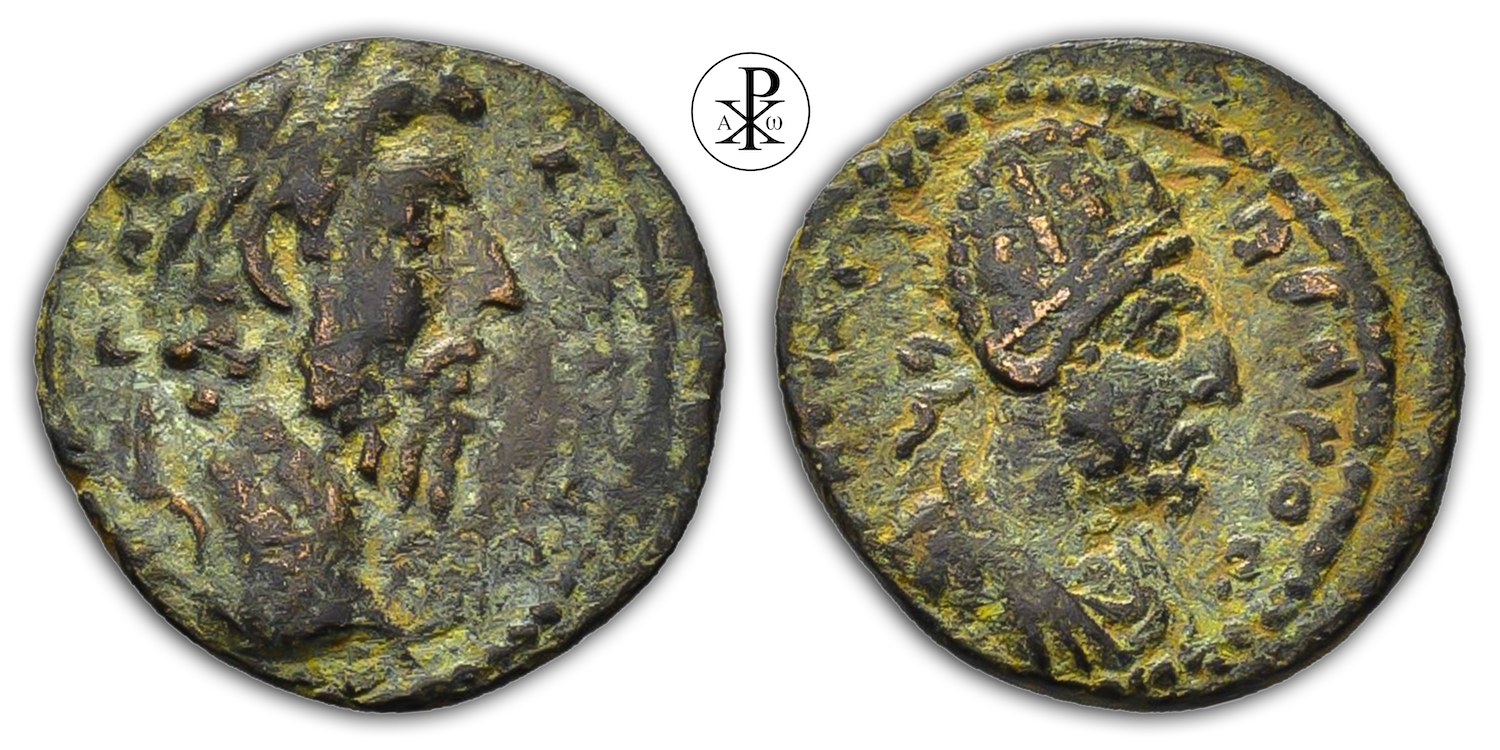Lucius Imperator Caesar Marcus Aurelius Commodus Antoninus Augustus
Reign: Abgar VIII; under Marcus Aurelius or Commodus
Mint: Edessa, Mesopotamia
Date: 177/192 AD
Nominal: Bronze
Material: AE
Diameter: 16mm
Weight: 2.10g
Reference: RPC IV.3 6491
Reference: BMC 11–13
Reference: SNG Copenhagen 193 and 195
RPC Online: https://rpc.ashmus.ox.ac.uk/coins/4/6491
Rare: Specimens 27 (27 in the core collections)
Provenance: Biga Numismatics Drunen, Netherlands (Auction 19, Lot 97)
Pedigree: –
Obverse: Laureate head of Commodus, right
Inscription: [AVT ΚΑΙϹΑΡ] ΚΟΜΟΔΟϹ
Translation: Autokrator Kaisaros Komodos
Translation: Imperator Caesar Commodus
Reverse: Draped bust of Abgar VIII (bearded) wearing diademed tiara, right
Inscription: ΑΒΓΑΡΟϹ [ΒΑϹΙΛЄVϹ]
Translation: Abgaros Basileus
Translation: King Abgar [VIII]
Comment: Urfa is believed to be identical to the Hurrian Urshu, which is mentioned around 2000 BC in Sumerian, Akkadian and later in Hittite cuneiform texts. Ephräm the Syrian preserves the legend that King Nimrod founded the city. The city was conquered by Alexander. For reasons of power politics, Seleucus I refounded the city under the Macedonian name of Edessa. The date of foundation is usually given as 303 BC. After the disintegration of the Seleucid Empire, the independent petty kingdom of Osrhoene arose around Edessa. Under Roman dominance, the city initially retained its independence. Pompey confirmed Abgar II of Edessa in office after 67 BC. The latter then seems, according to Plutarch, to have played an important role in the defeat of Crassus in 53 BC. Thereafter, Edessa, together with the Osrhoene, became a dependent Parthian client kingdom under its own princes. In 49 AD, Abgar V is mentioned by Tacitus (Annals XI,12) as “King of the Arabs”. When Emperor Trajan stayed in Antioch in 114 AD, the king of Edessa, also named Abgar, brought him gifts, including over 200 horses. But already in 116 AD Abgar fell away from the Romans and the city was destroyed. Trajan’s successor Hadrian had to vacate the area again and installed a Parthian prince as ruler of Edessa in 117 AD. A short time later, the Osrhoene was once again firmly part of the Parthian sphere of influence. Then in 123 AD a native dynasty under Manu VII came to rule. Until 160 AD, there were no coins by which a “Kingdom of Edessa” could be proven. The oldest coins survive from King Wael bar Sahru (163-165 AD), who was installed by the Parthians. From King Manu VIII (139-163 AD, 165-176/9 AD) a coin is preserved showing him with the tiara. In 165 AD, during another Roman-Parthian war, the city rebelled against the Parthians and opened the gates to Roman troops, the ruler became a Roman client king; but still the emperors refrained from annexation. In 194 AD, Edessa rebelled against the Romans and was subsequently subjugated by Emperor Septimius Severus. Abgar IX (212-214 AD) briefly succeeded his predecessor on the throne. However, the new emperor Caracalla had him deposed and killed, ending the rule of the Edessian kings and making the city a Roman colonia and the capital of the Roman province of Osrhoene in 214 AD. However, local princes seem to have continued to exist; for example, an Edessian phylarch named Abgar moved to Rome with his family in 243 AD. Abgar X minted the last coins with the Greek circumscription Abgaros Basileus (“King Abgar”) under Emperor Gordian. In 260 AD, the Romans under Valerian were defeated by the Persian Sassanids under Shapur I near Edessa, and the emperor fell into captivity. Edessa had long competed with the cult of the moon god Sin in nearby Harran. The worship of the goddess Taratha was significant. On the other hand, under the tolerant King Abgar VIII (176/9-212 AD), of whom a large number of coins have survived, the first Christian churches were allegedly built.
Abgar VIII (Lucius Aelius Septimius Abgar VIII, the Great) was a son of Manu VIII and king of Edessa from about AD 176/9. He took the name Lucius Aelius in 191/192 AD in honour of the Roman Emperor Commodus. After Commodus’ assassination, he supported the counter-emperor Pescennius Niger. In 194 AD, he was defeated by the emperor Septimius Severus, then submitted to him the following year, took the additional name Septimius in his honour and handed over his sons as hostages. From then on, he loyally stood by the Roman emperor and therefore did not support the Parthians. Septimius Severus recognised him for this as a client king and “king of kings” in 198 AD. Abgar had coins minted with the portrait of Septimius Severus on one side and his portrait on the other. Abgar’s palace fell victim to a flood in 201, according to the Chronicle of Edessa. Later, Abgar VIII is said to have paid a visit to the city of Rome. His son Abgar IX succeeded him on the throne in 212 AD. Among Abgar VIII’s childhood friends was the Syrian Christian Gnostic Bardesanes. It is possible that Abgar VIII converted to Christianity, but the church father Eusebius of Caesarea reports nothing of a conversion of Abgar in his church history. Bardesanes, on the other hand, relates in his Book of the Laws of the Lands that Abgar VIII, after his conversion, pronounced a prohibition against future emasculations in honour of the Semitic deity Atargatis; perhaps, however, this news is a subsequent orthodox revision of the original text. The early Christian chronicler Sextus Iulius Africanus paid his respects to Abgar VIII around 195 AD and classified him as a “holy man”, but whether he meant that the king was a Christian is not certain. At any rate, Christians lived in Edessa at the time of the king and Abgar VIII himself was at least open to Christianity. Abgar VIII probably had Roman citizenship.
